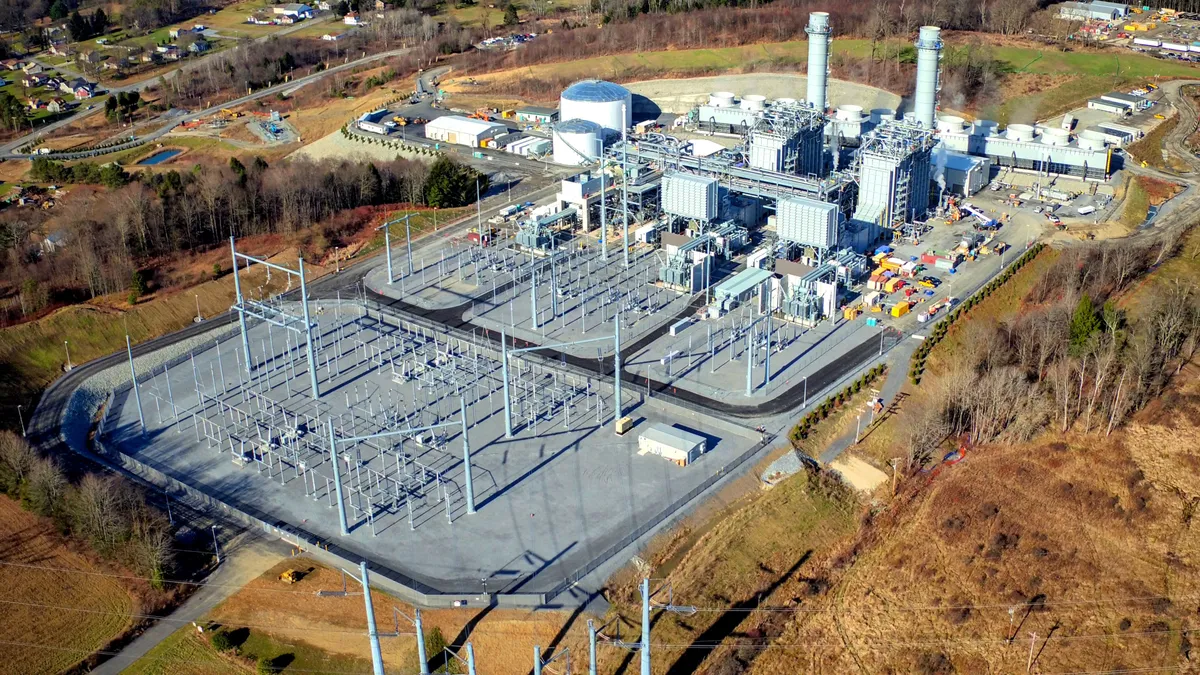Dive Brief:
- Natural gas is a critical part of the U.S. transition to a decarbonized power sector, top executives from three major utilities agreed on Tuesday. But its role will decline over time, and gas power plants will have to adapt to new technologies and fuels to reduce the risk of becoming stranded assets, said the recently elected board members of the investor-owned utility advocacy group, Edison Electric Institute (EEI).
- "There's no way to get to net zero without gas transitioning and eventually being either fully captured in terms of carbon or replaced with a different fuel," Gerry Anderson, executive chairman at DTE Energy, said Tuesday at EEI's "Road to Net Zero" conference. "As we permit new natural gas turbines, I think all of us need to be aware that someday they better be flexible enough to accept carbon capture, or in some way flexible to accept hydrogen," he continued.
- Anderson was elected this week as the new chairman of EEI's board, alongside two new vice chairmen who echoed the persisting importance of natural gas: Warner Baxter, chairman, president and CEO of Ameren Corp., and Pedro Pizarro, president and CEO of Edison International.
Dive Insight:
While coal-fired generation continues its decline in the U.S., utilities are proposing to spend billions of dollars on new gas plants in the coming years.
Some groups have pushed back against such plans in state regulatory proceedings, asserting that with rising clean energy and decarbonization goals, such investments risk becoming stranded assets.
For example, the advocacy group Vote Solar and the Energy Transition Institute released analysis in January that new gas resources from Duke Energy could create $4.8 billion in stranded fossil fuel assets through 2074. Duke's long term resource plans include the option for up to 9.6 GW of new gas resources.
Looking at the power sector more broadly, Utility Dive's 2021 State of the Electric Utility report, based on a survey of utility executives and other power sector professionals, shows a mixed outlook for gas.
While 30% of survey respondents said natural gas would decrease in the next 10 years — compared with 13% who said the same thing in the 2017 report — nearly 38% of respondents said they expect natural gas capacity to increase in the next 10 years.
Utilities wouldn't be making these investments in new gas if they thought they weren't going to be viable, companies assert.
"There has to be a clear understanding that there is a role for natural gas," said Baxter. "And this isn't just a five-year role or an eight-year role, no one's going to spend that kind of money and think it's going to go away," he added.
Utilities see the continued use of gas as critical to maintaining power system reliability as coal-fired power declines and renewable energy expands. But its role will change over time, Anderson noted.
"As we increase our investment in renewables, [natural gas asset] use and capacity factors will decline and eventually will be quite low. They'll probably be used more like peakers than baseload suppliers. And then eventually we're going to need to transition them either to carbon capture or to a different fuel, some mix of renewable and carbon capture or hydrogen," he said.
Pizarro concurred, saying "you do need gas, both in terms of reliability and affordability."
Edison International's analysis of California's path to statewide carbon neutrality in 2045 showed all gas use down about 50% from current levels. "However, that means that half the gas is still flowing," he noted.
"We still see something like 6% of the electrons serving California in 2045 being produced by natural gas," Pizarro said. Some 40% of that gas will be renewable natural gas, he noted. "And there is ... a significant amount of carbon capture that is part of the overall equation."
Preserving some gas use in the power sector, even in a carbon neutral world, makes economic sense, according to Pizzaro.
"That approach, we found, was a lot cheaper than taking a lot of dollars to take out the very last gas molecule — or the very last CO2 molecule, for that matter — from the power sector. Instead, you can spend that pile of dollars on getting out a lot more CO2 molecules from other sectors, in preserving the flexibility of some natural gas in the system."















